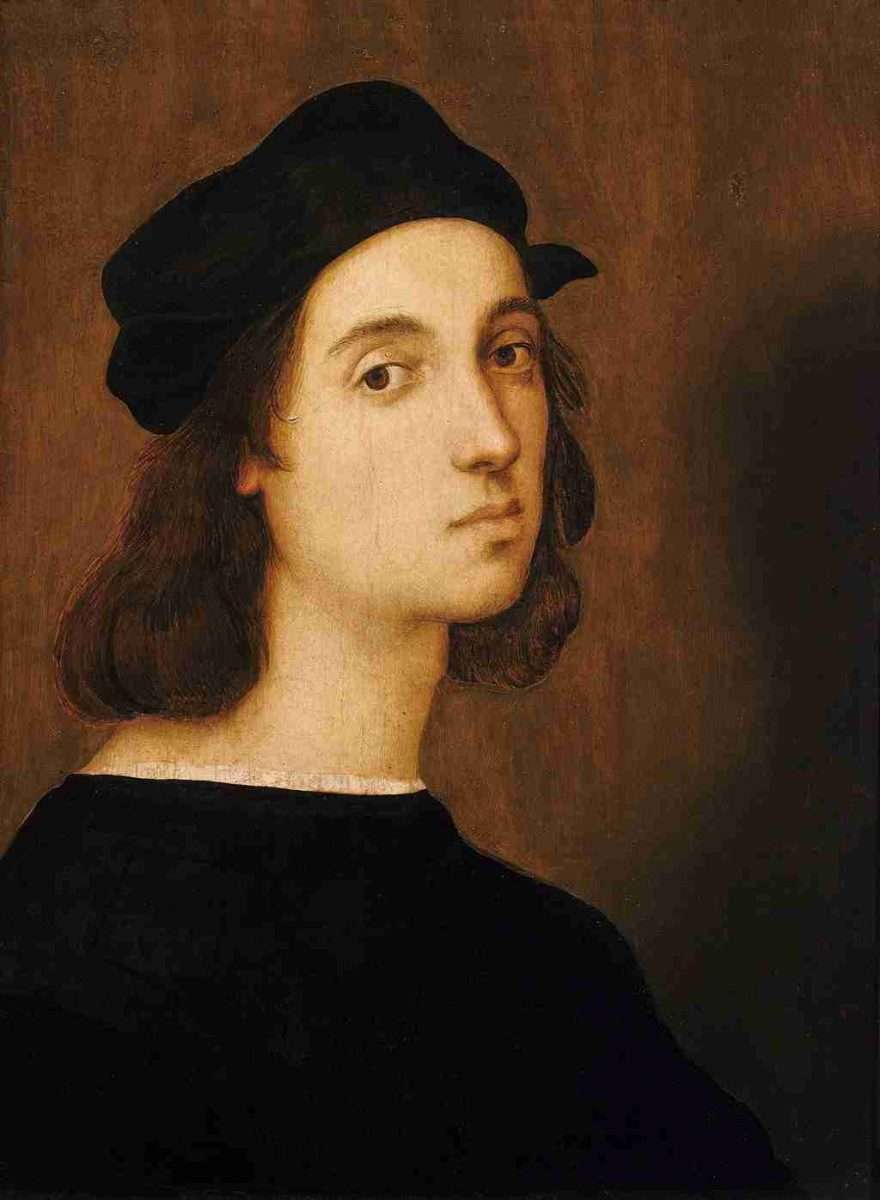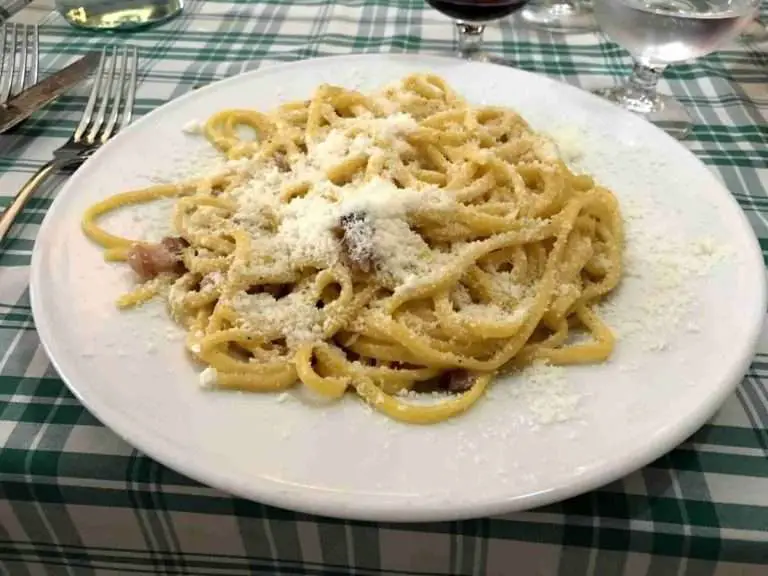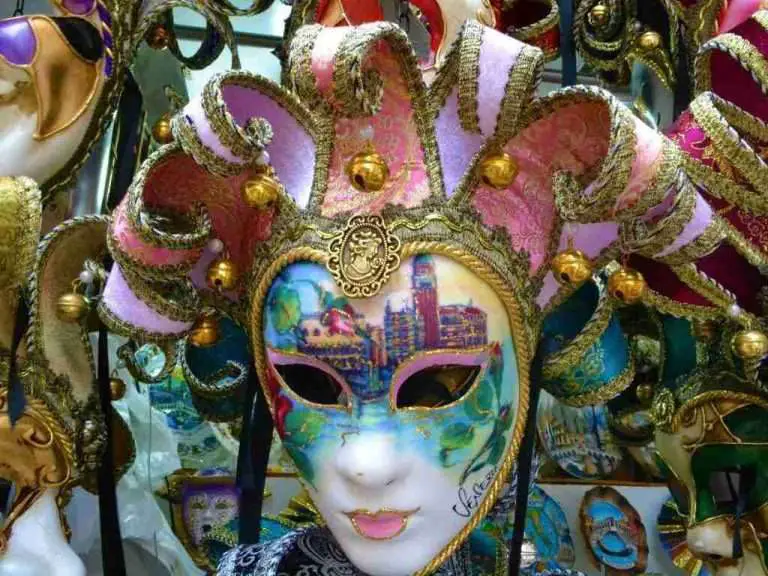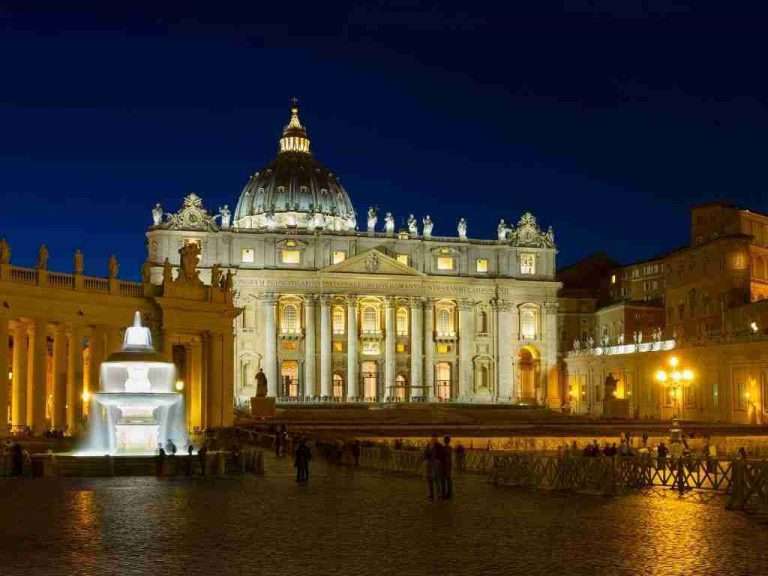
Only 37 when he died in 1520, Raphael was one of the most influential artists of his day.
During his short life, Raphael studied under Perugino and worked alongside Michelangelo in the Vatican.
His tomb is in the Pantheon in Rome.
Raphael 500 Exhibit

April 6, 2020, marked 500 years since the death of Raffaello Sanzio, the man known simply as Raffaello or Raphael. A few museums around the world, including in Berlin and London, celebrated the painter’s works with special exhibitions. While many of his paintings were temporarily reunited in Rome for a huge show at the Scuderie del Quirinale.
The exhibition included paintings from museums outside Italy, including the Louvre, the National Gallery of London, and the Prado. Other paintings in the exhibit came from Italian museums, including from museums in Bologna, Brescia, and Naples. Paintings from the Uffizi Gallery in Florence “provide[d] the backbone for the exhibition,” according to The Art Newspaper.
The Raphael exhibit was shut down almost as soon as it began because of the coronavirus pandemic. When it reopened, there was such huge demand – both from Italians and those who are able to travel to Italy – that the Scuderie del Quirinale extended its run and hours.
Very few of Raphael’s paintings remain in their original locations. But I have tried to piece together the Raphael story chronologically, where possible, so that readers can have a basic understanding of Raphael’s movements, life, and work.
Use the Table of Contents above to skip around between cities and regions.
Raphael in Le Marche
Raffaello Sanzio was born in Urbino. Le Marche, in the spring of 1483. His father, Giovanni Santi, was the court painter for the Duke of Urbino. So Raphael was exposed to art and wealthy patrons at a very young age.

You can visit the Casa Raffaello in Urbino to see where the artist was born. The museum has copies of his works on display and other artifacts connected to his life and Urbino during the late 15th century. It is also home to the Raphael Academy.

To see Raphael’s works in the town where he was born, you have to head to the Galleria Nazionale delle Marche, located in the Ducal Palace where Raphael’s father once worked. The National Gallery of the Marches contains Raphael’s Portrait of a Young Woman (La Muta), a Mona Lisa-esque portrait that the artist painted at age 24.
Raphael in Umbria
Raphael was an orphan by age 11. Some historians believe that this is when he went to work as an apprentice in nearby Umbria. Master painter Pietro Vannucci from Perugia, also known as Perugino, was Raphael’s mentor throughout his life.
Raphael earned the title of “master painting” while working in Umbria, mostly in the town of Città di Castello, between 1499 and 1504. It was during this time that Raphael received what some believe to be his first commission, the Baronci Altarpiece for the church of Sant’Agostino. Fragments of this work, heavily damaged by an earthquake in 1789, are today in museums in Brescia and Naples.
Raphael painted some of his most famous paintings during the time he spent in Umbria. Those paintings are today located in Florence, Milan, and Rome, as well as in other museums around the world.
While Raphael’s time in Umbria was formative, only two locations in the region still house his art.
The Pinacoteca Comunale di Citta di Castello houses a work painted solely by Raphael. On display there is a damaged processional banner, known as the Gonfalone della Santissima Trinita, believed to have been painted by Raphael some time between 1499 and 1502. The museum is also home to works from Umbrian painters that influenced Raphael, including Luca Signorelli.
In Perugia, you can visit the San Severo Chapel, which features Raphael’s fresco of the “Holy Trinity with Saints.” Raphael did not complete the work before his death; his mentor Perugino added the saints.
On the occasion of the 500th anniversary of Raphael’s death, Umbria Tourism has put together Raffaello in Umbria, an informative website about the artist’s time in the region.
Raphael in Tuscany and Florence
There is evidence that Raphael may have assisted the artist Pinturricchio, a Tuscan student of Perugino, with designs for the Piccolomini Library in Siena in 1502. But Raphael’s time in Tuscany (from 1504/5-1508), known as his Florentine Period, probably has as much to do with the painting techniques Raphael picked up from Tuscan master artist Leonardo da Vinci as it does with the artist’s time in the city.
The largest concentration of Raphael’s paintings outside of Rome and Vatican City is in Florence divided among two museums – the Uffizi and the Pitti Palace – which you can visit on a combined ticket.
Uffizi Gallery

Italy’s most important museum for Renaissance art, the Uffizi Gallery, has several of Raphael’s works.
Among these paintings are Madonna of the Goldfinch, which many compare to Leonardo’s compositions; Portraits of Agnolo and Maddalena Doni; and Raphael’s Self Portrait. The Uffizi also has a number of Raphael’s sketches and drawings in its Collection of Prints and Drawings on the first floor of the museum.
Get tickets for the Uffizi Gallery in Florence or buy a combined ticket
Pitti Palace

The other museum in Florence with a large holding of Raphael art is the Palatine Gallery of the Palazzo Pitti, the former Medici palace.
Among the highlights of Raphael’s Pitti paintings are “La Donna Velata” (The Veiled Woman) and “Young Man with an Apple.”
Purchase tickets for the Palatine Gallery in the Palazzo Pitti or buy a combined ticket
Raphael in Bologna

Raphael never worked in Bologna. But one of his late paintings ended up there.
Raphael painted the St. Cecilia Altarpiece while in Rome, though the work was intended for a chapel in Bologna’s San Giovanni in Monte church. The painting hung in the church from about 1518 to 1798, when Napoleon’s forces stole it and took it to Paris. In 1815, the painting was returned to Pinacoteca Nazionale di Bologna, where it has been ever since.
Raphael in Milan and Lombardy
Three cities in Lombardy have museums with works of art by Raphael: Milan, Bergamo, and Brescia.
Biblioteca and Pinacoteca Ambrosiana

The Biblioteca Ambrosiana, renowned as the home of Leonardo da Vinci‘s Codex Atlanticus notebook, also houses what it calls “one of the most precious artworks in the City of Milan.” This precious artwork is Raphael’s preparatory drawing for the School of Athens, one of the most famous frescoes in the Vatican.
The cartoon, the largest Renaissance cartoon still in existence, was restored over four years in advance of the Raphael quincentenary and went back on display in March 2019. The New York Times wrote about the restoration and Raphael’s mastery if you want to learn more.
Pinacoteca Brera

A 15-minute walk separates two Raphael artworks in Milan. Beyond the School of Athens cartoon is the artist’s “Marriage of the Virgin” in the Pinacoteca di Brera.
Raphael painted the harmoniously balanced “Marriage of the Virgin” while in Città di Castello as the pupil of Perugino. It is one of several Renaissance masterpieces on view at the Pinacoteca di Brera.
Bergamo – Accademia Carrara

Raphael’s “St. Sebastian” is one of the masterpieces housed in the Accademia Carrara in Bergamo. Raphael was barely 20 years old when he painted this refined image of the martyr.
Brescia – Pinacoteca Civico Tosio Martinengo

Brescia’s Pinacoteca Civico Tosio Martinengo is home to two paintings by Raphael.
“Angel” is a fragment from the Baronci Altarpiece, Raphael’s first recorded commission. Raphael painted the altarpiece for the church of Sant’Agostino in Città di Castello.
After the Baronci Altarpiece was damaged by an earthquake in 1789, it was divvied up and sent to various museums and private collections. Naples Museo di Capodimonte is the only other Italian museum with a part of this altarpiece on display.
Brescia’s Pinacoteca also houses Raphael’s “Christ Blessing,” which he painted in 1505/6.
Raphael in Naples

Outside of the Vatican Museums, the Museo e Real Bosco di Capodimonte in Naples is the largest museum on the Italian peninsula. The former Bourbon palace and estate has the largest collection of paintings from the Neapolitan school and many Renaissance paintings, including one Raphael.
Like Raphael’s “Angel” in Brescia, “God the Father and the Virgin Mary” is a fragment from the Baronci Altarpiece.
The Museo e Real Bosco di Capodimonte is located about 30 minutes from the city center of Naples. It offers a shuttle bus at Piazza dei Plebiscito and the bus fare includes admission to the museum. If you go, wear comfortable shoes so you can hike around the grounds of the “Real Bosco” (the royal park or forest).
Raphael in Rome
Rome is central to the life and work of Raphael. The artist moved here in 1508 and worked for Popes Julius II and Leo X, as well as a few other aristocratic patrons. Raphael flourished in Rome for 12 years before his untimely death in 1520.
Raphael in the Vatican and Papal Apartments

Raphael’s best-known works are in the Vatican Museums, and are probably the most famous frescoes in the Vatican after those by Michelangelo in the Sistine Chapel.
Raphael Rooms in the Vatican Museums
Raphael painted four rooms in the Vatican, known collectively as the Raphael Rooms. The Stanza della Segnatura, Raphael’s first commission in the Vatican, is where you will find the artist’s iconic fresco “School of Athens.” It features Michelangelo Buonarroti in the role of philosopher Heraclitus (the pensive sitting man up at the front of the painting).
The two master artists worked in the Vatican at the same time. From 1508-1512, Michelangelo painted the Sistine Chapel while Raphael painted the papal apartments. The story goes that Raphael got a sneak peek of Michelangelo’s frescoes in the chapel and was so wowed that he decided to pay homage to the older artist by painting him into the “School of Athens.”
The other three rooms of the Raphael Rooms are the Room of Constantine, the Room of Heliodorus, and the Room of the Fire in the Borgo. Raphael was responsible for most of the decorations in the rooms of Heliodorus and the Fire in the Borgo. Raphael’s team of assistants completed most of the work in the Room of Constantine.
The Pinacoteca in the Vatican Museums

The Vatican Museums holds several other significant works by Raphael, from his earliest to his last days as a painter.
Head to the Pinacoteca in the Vatican Museums to find Raphael’s Oddi Altarpiece, which he originally painted for the church of San Francesco al Prato in Perugia between 1502-1504.
This altarpiece is made up of four panels on which Raphael painted four scenes: The Crowning of the Virgin, the Annunciation, the Adoration of the Magi, and Presentation at the Temple.
Two other major Raphael works in the Vatican Pinacoteca are the “Madonna of Foligno,” which once hung in Rome’s Santa Maria in Aracoeli, and the Transfiguration. The latter is renowned as the “world’s first famous oil painting.” It was also Raphael’s last painting before his early death.
Purchase tickets for the Vatican Museums
Villa Farnesina

Not far from the Vatican Museums, on the same side of the River Tiber, is one of Raphael’s more delightful frescoes. Raphael painted “The Triumph of Galatea” for his wealthy friend Agostino Chigi, who later sold the villa to the Farnese family. Hence the name Villa Farnesina.
Raphael and his apprentices also frescoed the vast loggia of the Villa Farnesina, decorating the walls, ceilings, and niches with allegorical scenes, garlands, and exotic animals and fruits. Raphael’s Loggia of Cupid and Psyche has been meticulously photographed and digitized in advance of the Raphael anniversary, the results of which you can see here.
The Villa Farnesina, on the northeastern fringe of Trastevere, is usually a nice respite from the Rome crowds. But that may not be the case during 2020.
Galleria Borghese
One of Rome’s best museums, the Galleria Borghese, houses several Raphael paintings.
The museum, which is famous for its incredible collection of Bernini sculptures, highlights two Raphael works among its masterpieces: “The Deposition” and “Young Woman with a Unicorn.”
Raphael painted “The Deposition” for Atalanta Baglioni, head of a noble family from Perugia, to commemorate the death of her son. The altarpiece remained in Perugia’s church of San Francesco al Prato until 1608 when men working for art collector and papal nephew Scipione Borghese stole it from the church.
“Young Woman with a Unicorn” is notable for its resemblance, in pose and composition, to Leonardo’s Mona Lisa. Raphael painted this portrait during his time in Umbria. Fun fact – the unicorn was originally a dog. You can see in the woman’s red cloak where Raphael painted over its floppy ears.
Galleria Borghese is one of Rome’s best museums thanks to its timed ticketing system, which limits how many visitors can enter at a time. This means that you must reserve tickets to Galleria Borghese, even on free museum days. I recommend you do this weeks in advance of your visit to Rome.
Purchase your tickets to the Galleria Borghese
Palazzo Barberini

My absolute favorite work by Raphael is La Fornarina in the Palazzo Barberini.
This bare-breasted portrait features Raphael’s favorite lover and muse, Margarita Luti. Margarita was the daughter of a baker (Il Fornaio), which is where the name “Fornarina.” She was also the model that Raphael used for his Donna Velata portrait, which is today in the Pitti Palace in Florence (see above).
La Fornarina is at once sacred and profane, timid and playful. And the detail of Raphael’s signature, on a ribbon around the subject’s upper arm, is a lovely touch if not a territorial marking by the artist.
Raphael Art Elsewhere in Rome
Rome drips with Raphael art, and that even includes paintings that rarely get mentioned among his masterpieces. These may not be the artist’s most recognizable works of art, but they are still Raphaels.

One of these lesser-known pieces is in the Galleria Doria Pamphilj, a luxurious house museum in Rome. Raphael painted the “Double Portrait,” of two writers from Venice, during his time in Rome. The painting has been in the Doria Pamphilj’s personal collection since 1603.
Then there are the free-to-see Raphael paintings in two churches in Rome. That’s right, as of this writing, you can see two works from Raphael in Rome for free. The two churches where they reside are only five minutes from one another.

Romans particularly love Raphael’s “Sibyls” in the church of Santa Maria della Pace. These frescoes, slightly reminiscent of Michelangelo’s sibyls in the Vatican, decorate the top of a door just beyond the entrance of the church.

Meanwhile, in the church of Sant’Agostino, Raphael painted the Prophet Isaiah, another fresco that draws heavy inspiration from Michelangelo’s works in the Sistine Chapel. This often-overlooked Renaissance-era church near Piazza Navona also contains an original Caravaggio.

Raphael was also an architect during his short life. But few of his architectural works survived in their original form.
An exception to this is the Chigi Chapel in Rome’s church of Santa Maria del Popolo. Raphael drew up the plans for this chapel around 1512. But his death and the death of his patron and wife delayed the completion of the chapel. But according to some preparatory drawings, the chapel was built and decorated to Raphael’s specifications.
Raphael’s Tomb in the Pantheon
Raphael was a very skilled artist at an early age and his work for two popes made him famous during his time. But it is perhaps his early death, in his prime at age 37, sealed his reputation as one of the most beloved painters of the Renaissance.
Raphael died on Good Friday in 1520, which fell on 6 April that year. The legend is that the artist “was killed by too much sex.” According to Giorgio Vasari:
Raphael kept up his secret love affairs and pursued his pleasures with no sense of moderation. And then on one occasion he went to excess, and he returned home afterwards with a violent fever which the doctors diagnosed as having been caused by heat-stroke. Raphael kept quiet… [and] instead of giving him the restoratives he needed they bled him until he grew faint.”
Giorgio Vasari – Lives of the Artists
Upon his death, according to an 1816 biography, Raphael’s body “lay in state in the hall of his own house” before his body was transferred “with great funeral pomp to the Pantheon.” Raphael’s tomb bears this inscription:
THIS IS RAPHAEL. IN HIS LIFE GREAT MOTHER NATURE FEARED DEFEAT AND IN HIS DEATH SHE HERSELF FEARED TO DIE.
Raphael’s was the only tomb in the Pantheon for more than 300 years. In 1878, King Vittorio Emanuele II was buried there. The two other tombs in the Pantheon are that of King Umberto I and Queen Margherita.
Conclusion
Raphael was an exceptionally talented and prolific painter. He left behind many works of art that are today recognizable throughout the world. Luckily, the greatest concentration of Raphael’s paintings remain in Italy, the country of his birth and death.
Of course, we humans tend to exalt those artists who die young. Like some art lovers, I can’t say that he was my favorite Renaissance artist. But the 500th anniversary of Raphael’s time on earth is sure to be an awe-inspiring celebration.
Last updated on May 17th, 2023Post first published on January 15, 2020













